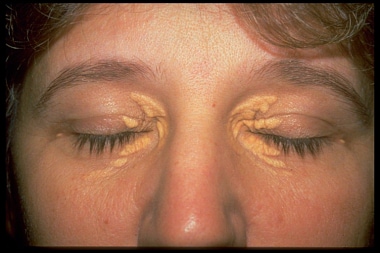Background
Xanthelasma palpebrarum is a prevalent, benign dermatologic condition characterized by the formation of yellow-white, lipid-laden plaques on the upper and lower eyelids, most commonly near the inner canthus. [1, 2] While xanthelasma can be associated with dyslipidemias, the majority of patients do not exhibit abnormal lipid profiles.
Clinically, xanthelasma can present as soft, semisolid, or calcareous plaques, often symmetrical, and may involve all four eyelids. The condition is progressive, with lesions tending to coalesce and become permanent over time. The term "xanthelasma" is derived from the Greek words "xanthos" (yellow) and "elasma" (beaten metal plate), indicative of its distinctive coloration and texture. Regular monitoring and patient education regarding potential lipid abnormalities are recommended.
Diagnosis is primarily clinical, based on the characteristic appearance of the lesions. [1, 2] Although treatment is not medically necessary, excision or other removal methods may be considered for cosmetic reasons. It is essential to evaluate and manage any underlying dyslipidemias, as they may pose cardiovascular risks.
Pathophysiology
Xanthelasma are a specific type of xanthoma that appear on the eyelids. They are deposits of yellowish, cholesterol-rich material that can develop in various parts of the body due to different disease conditions. Xanthomas represent cutaneous signs of lipidosis, where lipids accumulate in foam cells within the skin; they often are linked to hyperlipidemias, which can be either primary or secondary. Some cases are associated with changes in lipoprotein composition or structure, such as reduced levels of high-density lipoprotein (HDL). These lesions commonly are found in patients with type II hyperlipidemia and the type IV phenotype.
Individuals with XP exhibit higher levels of atherogenic LDL and a significantly increased risk for atherosclerosis compared to controls, highlighting the need for careful monitoring and targeted interventions to prevent cardiovascular diseases in these patients. [1]
Epidemiology
Frequency
United States
Xanthelasma are not uncommon.
International
In India, the incidence of xanthelasma may range from 0.3%-1.5%. [3]
Mortality/Morbidity
These lesions have no premalignant potential; however, see Differentials.
A study by Christoffersen et al finds that xanthelasmata can be a predictor of risk for myocardial infarction, ischemic heart disease, severe atherosclerosis, and death in the general population, independent of well-known cardiovascular risk factors (eg, plasma cholesterol, triglyceride concentrations). On the other hand, arcus senilis of the cornea has been found not to be an important independent predictor of risk. [4]
Sex
In case studies of patients with xanthomatosis, a predominance of xanthelasma in women has been seen; women, 32%, and men, 17.4%.
Age
The age of onset ranges from 15-73 years, with a peak in the fourth and fifth decades.
Prognosis
Recurrence is common. Patients need to be aware that studies completed after surgical excision showed recurrence in up to 40% of patients. This percentage is higher with secondary excisions. Of these failures, 26% occurred within the first year and were more likely to occur in patients with hyperlipidemia syndromes and in those with all four eyelids affected.
-
Case presentation of excision of recurrent xanthelasma. Recurrent xanthelasma bilateral upper lids; previous excision combined with blepharoplasty; patient insistent on repeat excision and blepharoplasty; advised of lagophthalmos risk due to medial position and lack of medial dermatochalasis.
-
Close-up view of recurrent xanthelasma right upper lid. Note the scar from previous excision by a plastic surgeon. Careful examination reveals subtle infiltration in the lateral aspect of scar.
-
Xanthelasma. External view, 1 week after surgery. Sliding and rotational flaps from residual lateral dermatochalasis used for medial excisional gap.
-
Xanthelasma. Top image, 4 weeks after surgery; lower image, before surgery.
-
Xanthelesma of four eyelids in patient with hyperlipidemia.


